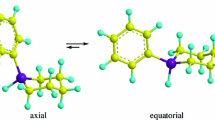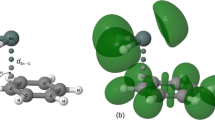Abstract
A theoretical study on the series of compounds “PhSeX”, where Ph = phenyl, Se = selenium and X = Cl, Br, I, CN or SCN, is reported and compared with previously reported experimental data. The molecular geometry for these PhSeX compounds was studied at the DFT/B3LYP level of calculation by means of the 6-311G(d,p) basis set. The equilibrium structures of the molecules were dependent on the method employed to compare the known solid structures. A topological study of the calculated PhSeX species, based on the AIM theory, was carried out to gain a deeper insight into the bonding nature and to find an explanation for the structural diversity exhibited by these PhSeX compounds. The results reported herein illustrate the subtle differences in the solid-state structures of PhSeX compounds.





Similar content being viewed by others
References
IUPAC (1995) Compendium of Chemical Terminology 67:1361
Birkenbach L, Kellermann K (1925) Über Pseudohalogene (I). Ber Dtsch Chem Ges 58:786–794
Holleman F, Wiberg N, Wiberg E (1995) Lehrbuch der Anorganischen Chemie, 101st edn. de Gruyter, Berlin
Tiecco M (2000) Electrophilic Selenium, Selenocylizations. Top Curr Chem 208:7–54
Wirth T (2000) Organoselenium chemistry: modern developments in organic synthesis. Springer, Berlin
Kubiniok S, du Mont WW, Pohl S, Saak W (1988) The reagent diphenyldiselane/Iodine: no phenylselenenyl iodide but a charge transfer complex with cyclic moieties. Angew Chem Int Edn 27:431–433
Barnes NA, Godfrey SM, Halton RTA, Mushtaq I, Parsons S, Pritchard RG, Sadler M (2007) A comparison of the solid-state structures of a series of phenylseleno-halogen and pseudohalogen compounds, PhSeX (X = Cl, CN, SCN). Polyhedron 26:1053–1060
Barnes NA, Godfrey SM, Halton RTA, Mushtaq I, Pritchard RG, Sarwar S (2006) Reactions of Ph4Se4Br4 with tertiary phosphines. Structural isomerism within a series of R3PSe(Ph)Br compounds. Dalton Trans 12:1517–1523
Klapötke TM, Krumm B, Mayer P (2004) Chemistry of C6F5SeLi and C6F5SeCl: precursors to new pentafluorophenylselenium(II) compounds. Z Naturforsch 59b:547–553
Allen FH, Kennard O, Watson DG, Brammer L, Orpen AG, Taylor R (1987) Tables of bond lengths determined by X-ray and neutron diffraction. Part 1. Bond lengths in organic compounds. J Chem Soc Perkin Trans 2:S1–S19
Akers C, Peterson SW, Willett RD (1968) A refinement of the crystal structure of KSCN. Acta Crystallogr B 24:1125–1126
Okulik N, Jubert AH, Castro EA (2002) Theoretical study of new pseudohalogen CS2N3 and some related compounds. J Mol Struct THEOCHEM 589–590:79–87
Okulik NB, Jubert A, Castro E (2006) Bonding in some covalent derivatives of the 1,2,3,4-thiatriazole-5-thiolate anion. A topological study. J Mol Struct THEOCHEM 770:13–22
Hohenberg P, Kohn W (1964) Inhomogeneous electron gas. Phys Rev 136:864–B871
Kohn W, Sham LJ (1965) Self-consistent equations including exchange and correlation effects. Phys Rev 140:A1133–A1138
Parr RG, Yang W (1989) Density functional theory of atoms and molecules. Oxford University Press, Oxford
Becke AD (1993) Density-functional thermochemistry. III. The role of exact exchange. J Chem Phys 98:5648–5652
Lee C, Yang W, Parr RG (1988) Development of the Colle-Salvetti correlation-energy formula into a functional of the electron density. Phys Rev B 37:785–789
Cambridge Crystallographic Data Center, 12, Union Road, Cambridge CB2 1EZ, UK
Clark T, Chandrasekhar J, Spitznagel GW, PvR S (1983) Efficient diffuse function-augmented basis sets for anion calculations. III. The 3-21 + G basis set for first-row elements, Li–F. J Comput Chem 4:294–301
Curtiss LA, McGrath MP, Blandeau JP, Davis NE, Binning RC Jr, Radom L (1995) Extension of Gaussian–2 theory to molecules containing third–row atoms Ga–Kr. J Chem Phys 103:6104–6113
Frisch MJ et al (2003) Gaussian 03, Revision C.02. Gaussian Inc, Wallingford, CT
Biegler-König FW, Bader RFW, Tang TH (1982) Calculation of the average properties of atoms in molecules II. J Comput Chem 3:317–328
Gans J, Shalloway D (2001) Qmol: A program for molecular visualization on Windows based PCs. J Mol Graph Model 19:557–559
Bader RFW (1990) Atoms in molecules. A quantum theory. Oxford University Press, Oxford
Acknowledgments
A.H.J. is a member of the Carrera del Investigador Científico, CIC, Buenos Aires and E.A.C. and N.B.O. are members of the career researcher of Consejo Nacional de Investigaciones Científicas y Técnicas, CONICET, Argentina.
Author information
Authors and Affiliations
Corresponding author
Rights and permissions
About this article
Cite this article
Okulik, N.B., Jubert, A.H. & Castro, E.A. Topological properties of some PhSeX compounds. J Mol Model 18, 913–920 (2012). https://doi.org/10.1007/s00894-011-1127-z
Received:
Accepted:
Published:
Issue Date:
DOI: https://doi.org/10.1007/s00894-011-1127-z




